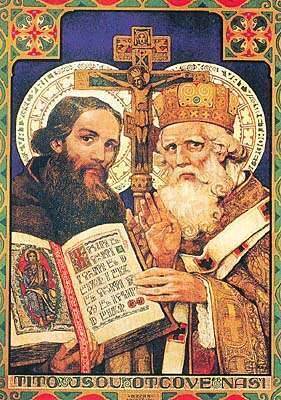
Obsah
Obsah
Portál

The Roman and Byzantian missions tackling paganism in Bohemia and Great Moravia. From 'Christianity in the Czech Lands' by Jan Royt
The first mention of Christianity in Bohemia dates to 845 when fourteen Czech princes, probably the leaders of various tribes, were christened in Regensburg. The subsequent Christianization of the country meant that new places of worship had to be built, and by the end of the century Prince Spytihněv had the rotunda of Saint Peter built at the hill fort of Budec. Ostensibly the earliest church building in the Czech lands, in both its dedication and its adherence to the Latin tradition it shows a possible Western influence, apparently that of the Regensburg mission.
In 863-864 Rostislav, the ruler of Great Moravía, invited Cyril and Methodius, two Byzantine monks and scholars from Thessalonika, to his land. The missionaries were the first to commit Old Slavonic to writing; Cyril developed the alphabet, named after him, that was used to record all Slavic languages. They translated fundamental ritual texts from Greek into Old Slavonic and introduced the Western liturgy in that language as well. Sites near present-day Mikulčice and Uherské Hradiště became the centers of the church in Great Moravia, and rotundas and basilicas were built. Methodius also christened the founder of the Přemyslid dynasty, Prince Bořivoj, and his wife, Ludmila. The royal couple founded the rotunda of Saint Clement at their fortified settlement of Levý Hradec. Pagan customs nonetheless survived among the common people; as late as 1092 Břetislav II of Bohemia issued a decree ordering the felling of groves and trees sacred to pagan ritual.
